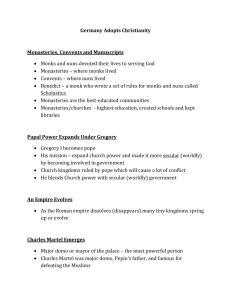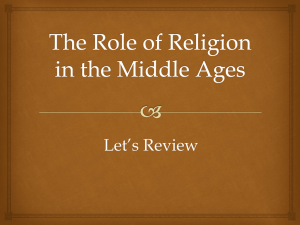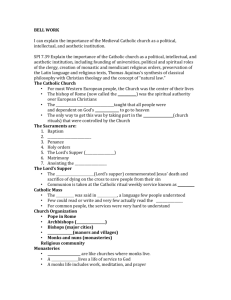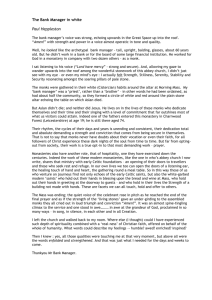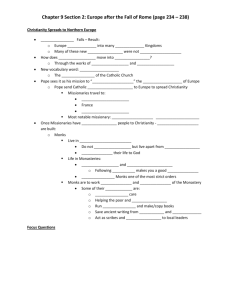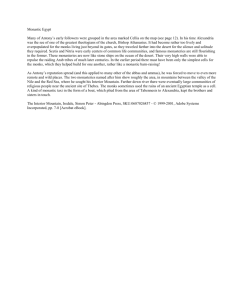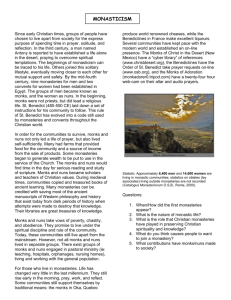The Roman Catholic Church was the single, largest
advertisement
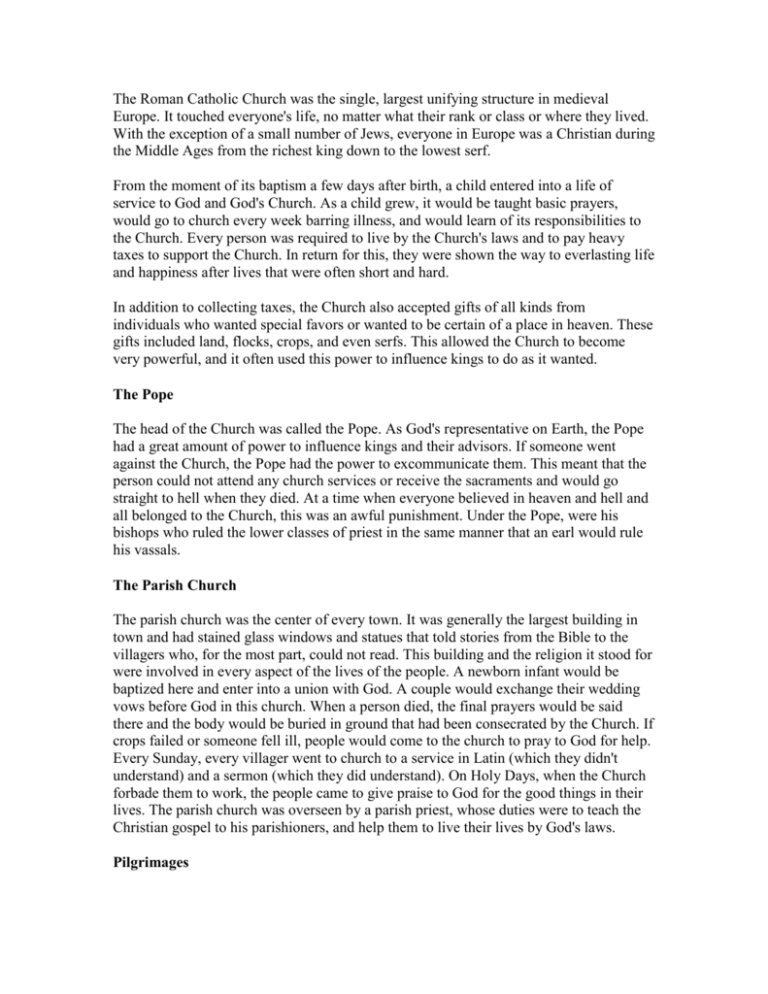
The Roman Catholic Church was the single, largest unifying structure in medieval Europe. It touched everyone's life, no matter what their rank or class or where they lived. With the exception of a small number of Jews, everyone in Europe was a Christian during the Middle Ages from the richest king down to the lowest serf. From the moment of its baptism a few days after birth, a child entered into a life of service to God and God's Church. As a child grew, it would be taught basic prayers, would go to church every week barring illness, and would learn of its responsibilities to the Church. Every person was required to live by the Church's laws and to pay heavy taxes to support the Church. In return for this, they were shown the way to everlasting life and happiness after lives that were often short and hard. In addition to collecting taxes, the Church also accepted gifts of all kinds from individuals who wanted special favors or wanted to be certain of a place in heaven. These gifts included land, flocks, crops, and even serfs. This allowed the Church to become very powerful, and it often used this power to influence kings to do as it wanted. The Pope The head of the Church was called the Pope. As God's representative on Earth, the Pope had a great amount of power to influence kings and their advisors. If someone went against the Church, the Pope had the power to excommunicate them. This meant that the person could not attend any church services or receive the sacraments and would go straight to hell when they died. At a time when everyone believed in heaven and hell and all belonged to the Church, this was an awful punishment. Under the Pope, were his bishops who ruled the lower classes of priest in the same manner that an earl would rule his vassals. The Parish Church The parish church was the center of every town. It was generally the largest building in town and had stained glass windows and statues that told stories from the Bible to the villagers who, for the most part, could not read. This building and the religion it stood for were involved in every aspect of the lives of the people. A newborn infant would be baptized here and enter into a union with God. A couple would exchange their wedding vows before God in this church. When a person died, the final prayers would be said there and the body would be buried in ground that had been consecrated by the Church. If crops failed or someone fell ill, people would come to the church to pray to God for help. Every Sunday, every villager went to church to a service in Latin (which they didn't understand) and a sermon (which they did understand). On Holy Days, when the Church forbade them to work, the people came to give praise to God for the good things in their lives. The parish church was overseen by a parish priest, whose duties were to teach the Christian gospel to his parishioners, and help them to live their lives by God's laws. Pilgrimages Pilgrimages were journeys made to places that held special religious significance. Usually, this was a shrine where a saint was buried or a visit to the Holy Land itself. Making a pilgrimage was long and often dangerous. Almost everyone traveled on foot and bandits and pirates lay in wait for the unarmed pilgrims. However, people went on these journeys anyways because they felt that prayers made at a saint's tomb were especially powerful. If a loved one fell ill, a relative might promise to make a pilgrimage if the person got better, or someone might go to show that they were sorry for their sins. Monks and Nuns Because religion was so important during the Middle Ages, many people devoted their whole lives to being closer to God and doing the Church's work. Sometimes, parents promised their children to this religious life in order to fulfill a promise to God and to ensure their children were never homeless or without food. These people became monks (if they were men) or nuns (if they were women) and lived apart from the rest of the people in special communities called monasteries and nunneries. Monks and nuns promised to always remain single, to be obedient to their superiors and to live a life of prayer. They ate simple food, dressed in simple clothes (called habits) and spent their days in silence, praying or working. They also attended many church services. There were seven main church services each day, the first at dawn and the last in the middle of the night. The Catholic Church was the only church in Europe during the Middle Ages, and it had its own laws and large coffers. Church leaders such as bishops and archbishops sat on the king's council and played leading roles in government. Bishops, who were often wealthy and came from noble families, ruled over groups of parishes called "diocese." Parish priests, on the other hand, came from humbler backgrounds and often had little education. The village priest tended to the sick and indigent and, if he was able, taught Latin and the Bible to the youth of the village. As the population of Europe expanded in the twelfth century, the churches that had been built in the Roman style with round-arched roofs became too small. Some of the grand cathedrals, strained to their structural limits by their creators' drive to build higher and larger, collapsed within a century or less of their construction. Monks and Nuns Monasteries in the Middle Ages were based on the rules set down by St. Benedict in the sixth century. The monks became known as Benedictines and took vows of poverty, chastity, and obedience to their leaders. They were required to perform manual labor and were forbidden to own property, leave the monastery, or become entangled in the concerns of society. Daily tasks were often carried out in silence. Monks and their female counterparts, nuns, who lived in convents, provided for the less-fortunate members of the community. Monasteries and nunneries were safe havens for pilgrims and other travelers. Monks went to the monastery church eight times a day in a routine of worship that involved singing, chanting, and reciting prayers from the divine offices and from the service for Mass. The first office, "Matins," began at 2 A.M. and the next seven followed at regular intervals, culminating in "Vespers" in the evening and "Compline" before the monks retired at night. Between prayers, the monks read or copied religious texts and music. Monks were often well educated and devoted their lives to writing and learning. The Venerable Bede, an English Benedictine monk who was born in the seventh century, wrote histories and books on science and religion. Pilgrimages Pilgrimages were an important part of religious life in the Middle Ages. Many people took journeys to visit holy shrines such as the Church of St. James at Santiago de Compostela in Spain, the Canterbury cathedral in England, and sites in Jerusalem and Rome. Chaucer's Canterbury Tales is a series of stories told by 30 pilgrims as they traveled to Canterbury.

